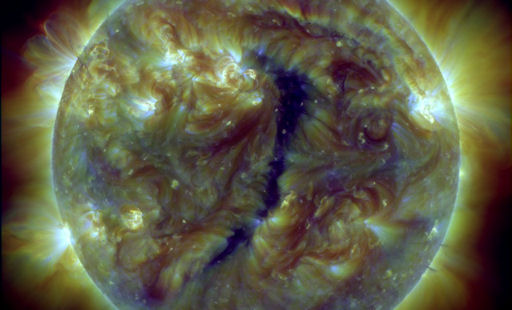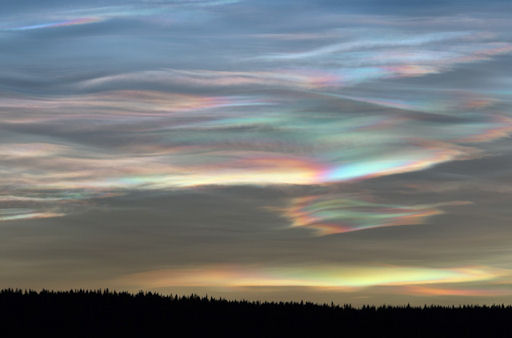Don't just watch shooting stars. Wear them! Authentic meteorite jewelry for Christmas is now available in the SpaceWeather Store. | | |
M-FLARE: Today at 1318 UT, Earth-orbiting satellites detected an M1-class solar flare (SDO movie). The source is a new sunspot emerging over the sun's northeastern limb.
RE-THINKING AN ALIEN WORLD: A distant super-Earth named "55 Cancri e" is wetter and weirder than astronomers thought possible. The discovery has researchers re-thinking the nature of alien worlds. [full story] [video]
CORONAL HOLE: NASA's Solar Dynamics Observatory is monitoring a dark gash in the sun's atmosphere--a coronal hole. It's the dark vertical feature in this extreme UV image taken on Jan. 13th:

Coronal holes are places where the sun's magnetic field opens up and allows the solar wind to escape. This yawning hole is about 120,000 km wide and more than a million km long. Solar wind flowing from its UV-dark abyss will reach Earth on Jan. 16th or 17th, possibly sparking auroras for high-latitude sky watchers. Aurora alerts: text, voice.
January 2012 Aurora Gallery
[previous Januaries: 2010, 2009, 2008, 2007, 2005, 2004]
POLAR STRATOSPHERIC CLOUDS: An apparition of polar stratospheric clouds is underway around the Arctic Circle. "It is almost as good as the aurora borealis," says Göran Strand, who took this picture last night from Östersund, Sweden:

Eric Schandall of Oslo, Norway, adds this report: "We have seen them for three evenings over Oslo, with the ones on Jan. 13th being the most dramatic and beautiful so far."
Also known as "nacreous" or "mother of pearl" clouds, these icy clouds form in the lower stratosphere when temperatures drop to around minus 85ºC. Sunlight shining through tiny ice particles ~10µm across produce the characteristic bright iridescent colors by diffraction and interference.
"Nacreous clouds far outshine and have much more vivid colours than ordinary iridescent clouds, which are very much poor relations and seen frequently all over the world," writes atmospheric optics expert Les Cowley. "Once seen they are never forgotten."
Comet Lovejoy Gallery
[previous comets: McNaught, Holmes, Lulin, Tuttle, Ikeya-Zhang]
Potentially Hazardous Asteroids (
PHAs) are space rocks larger than approximately 100m that can come closer to Earth than 0.05 AU. None of the known PHAs is on a collision course with our planet, although astronomers are finding
new ones all the time.
On January 14, 2012 there were 1272 potentially hazardous asteroids.
Notes: LD means "Lunar Distance." 1 LD = 384,401 km, the distance between Earth and the Moon. 1 LD also equals 0.00256 AU. MAG is the visual magnitude of the asteroid on the date of closest approach. | | The official U.S. government space weather bureau |
| | The first place to look for information about sundogs, pillars, rainbows and related phenomena. |
| | Researchers call it a "Hubble for the sun." SDO is the most advanced solar observatory ever. |
| | 3D views of the sun from NASA's Solar and Terrestrial Relations Observatory |
| | Realtime and archival images of the Sun from SOHO. |
| | from the NOAA Space Environment Center |
| | the underlying science of space weather |

